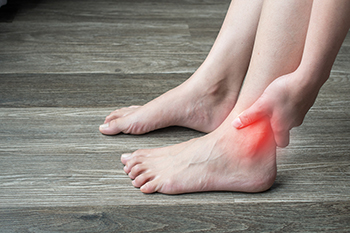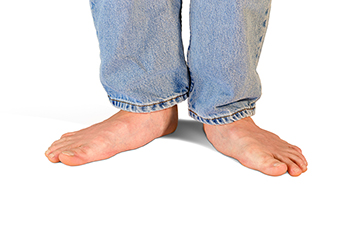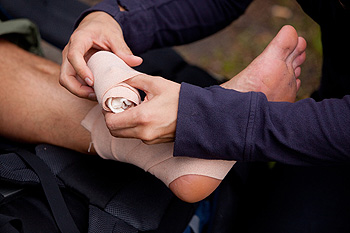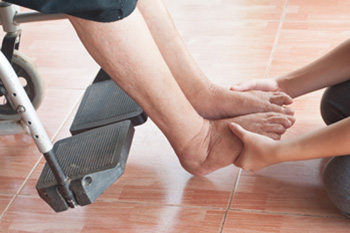
Blog (871)
Gout and Foods

The arthritic condition known as gout often causes extreme pain. The foot ailment affects the joints in the big toe, causing redness and swelling. Gout can develop for genetic reasons or from specific types of foods that are consumed, which are laden with purines. These can include red meat, shellfish, and drinks that are made with large amounts of sugar. Excess uric acid can be produced from these foods and converted into crystals that lodge in the joints of the big toe. People generally experience a gout attack for approximately one week, but it may resurface if eating habits are not changed. Episodes of gout may be prevented by drinking plenty of fresh water and engaging in a gentle exercise program. It is also beneficial to include fresh vegetables and fruits in your diet and to limit foods that have excess purines. If you are afflicted with gout, it is strongly suggested that you confer with a podiatrist who can guide you toward management and prevention techniques.
Gout is a foot condition that requires certain treatment and care. If you are seeking treatment, contact one of our podiatrists from Westland Foot & Ankle Specialists, P.C.. Our doctors will treat your foot and ankle needs.
What Is Gout?
Gout is a type of arthritis caused by a buildup of uric acid in the bloodstream. It often develops in the foot, especially the big toe area, although it can manifest in other parts of the body as well. Gout can make walking and standing very painful and is especially common in diabetics and the obese.
People typically get gout because of a poor diet. Genetic predisposition is also a factor. The children of parents who have had gout frequently have a chance of developing it themselves.
Gout can easily be identified by redness and inflammation of the big toe and the surrounding areas of the foot. Other symptoms include extreme fatigue, joint pain, and running high fevers. Sometimes corticosteroid drugs can be prescribed to treat gout, but the best way to combat this disease is to get more exercise and eat a better diet.
If you have any questions please feel free to contact our office located in Westland, MI. . We offer the newest diagnostic and treatment technologies for all your foot and ankle needs.
Gout Pain Can Be Managed
Ankle Pain Without Injury

One can have ankle pain even if they have not injured their ankle. This can occur from some underlying health conditions, such as autoimmune diseases or arthritis, and from unrelated foot ailments. Osteoarthritis, the most common form of arthritis, is when the cartilage between two bones erodes over time. Without cartilage in the ankle, the bones rub together and there can be pain and stiffness. Other types of arthritis, including rheumatoid arthritis, reactive arthritis, and gout are other conditions that can cause inflammation and leave the ankle feeling tender as well. Lupus and scleroderma are examples of autoimmune diseases that can have the same side effects. Of course, other foot and ankle ailments, like fallen arches and Achilles tendonitis can also cause ankle pain. Treatment depends on the root cause of the ankle pain. If you have such pain and there is no obvious reason for it, it is suggested that you see a podiatrist for a correct diagnosis and care regime.
Ankle pain can be caused by a number of problems and may be potentially serious. If you have ankle pain, consult with one of our podiatrists from Westland Foot & Ankle Specialists, P.C.. Our doctors will assess your condition and provide you with quality foot and ankle treatment.
Ankle pain is any condition that causes pain in the ankle. Due to the fact that the ankle consists of tendons, muscles, bones, and ligaments, ankle pain can come from a number of different conditions.
Causes
The most common causes of ankle pain include:
- Types of arthritis (rheumatoid, osteoarthritis, and gout)
- Ankle sprains
- Broken ankles
- Achilles tendinitis
- Achilles tendon rupture
- Stress fractures
- Bursitis
- Tarsal tunnel syndrome
- Plantar fasciitis
Symptoms
Symptoms of ankle injury vary based upon the condition. Pain may include general pain and discomfort, swelling, aching, redness, bruising, burning or stabbing sensations, and/or loss of sensation.
Diagnosis
Due to the wide variety of potential causes of ankle pain, podiatrists will utilize a number of different methods to properly diagnose ankle pain. This can include asking for personal and family medical histories and of any recent injuries. Further diagnosis may include sensation tests, a physical examination, and potentially x-rays or other imaging tests.
Treatment
Just as the range of causes varies widely, so do treatments. Some more common treatments are rest, ice packs, keeping pressure off the foot, orthotics and braces, medication for inflammation and pain, and surgery.
If you have any questions, please feel free to contact our office located in Westland, MI. . We offer the newest diagnostic and treatment technologies for all your foot care needs.
Heel Stretch for Plantar Fasciitis Relief

The condition that is known as plantar fasciitis affects the heel and arch of the foot. There is a band of tissue called the plantar fascia, which connects the heels to the toes. It is found on the sole of the foot, and it can become inflamed or torn for various reasons. These reasons can include wearing shoes that do not fit correctly, or standing on hard surfaces for most of the day. People who are overweight may be prone to getting plantar fasciitis, which may be a result of having the added weight the feet must bear. The pain may be worse in the morning when awakening, and may start to feel better when the foot is moved. Mild relief may be found when custom-made insoles are worn in the shoe, and the foot is frequently elevated. There are specific stretches that can be done, which may help to ease the discomfort from plantar fasciitis. The heel can be stretched by standing on a step while lowering one heel at a time until a gentle pull is felt. If you are afflicted with this condition, it is suggested that you confer with a podiatrist who can provide you with permanent relief options.
Plantar fasciitis can be very painful and inconvenient. If you are experiencing heel pain or symptoms of plantar fasciitis, contact one of our podiatrists from Westland Foot & Ankle Specialists, P.C.. Our doctors can provide the care you need to keep you pain-free and on your feet.
What Is Plantar Fasciitis?
Plantar fasciitis is the inflammation of the thick band of tissue that runs along the bottom of your foot, known as the plantar fascia, and causes mild to severe heel pain.
What Causes Plantar Fasciitis?
- Excessive running
- Non-supportive shoes
- Overpronation
- Repeated stretching and tearing of the plantar fascia
How Can It Be Treated?
- Conservative measures – anti-inflammatories, ice packs, stretching exercises, physical therapy, orthotic devices
- Shockwave therapy – sound waves are sent to the affected area to facilitate healing and are usually used for chronic cases of plantar fasciitis
- Surgery – usually only used as a last resort when all else fails. The plantar fascia can be surgically detached from the heel
While very treatable, plantar fasciitis is definitely not something that should be ignored. Especially in severe cases, speaking to your doctor right away is highly recommended to avoid complications and severe heel pain. Your podiatrist can work with you to provide the appropriate treatment options tailored to your condition.
If you have any questions please feel free to contact our office located in Westland, MI. . We offer the newest diagnostic and treatment technologies for all your foot and ankle needs.
Children’s First Shoes

Children’s feet are flexible and pliable when they are born. Each foot has 26 bones that will harden as the time for walking approaches. This generally occurs between eight and 18 months, and often parents notice their child walks with their toes inward. This usually corrects itself as the muscles, ligaments, and tendons become stronger within the foot. It is beneficial for the child to walk barefoot while indoors, and the foot can strengthen as the toes grip the floor. When it is time to walk outdoors, it is beneficial for the first pair of shoes to be made of flexible materials with a flat sole, and the feet need to be measured every few months to determine the correct shoe size. Additionally, the toes need to move freely in the chosen shoes, and laces or straps are recommended that can help to prevent excess movement. If you have questions about what type of shoes to purchase for your child’s growing feet, it is suggested that you confer with a podiatrist who can address any concerns you may have.
Making sure that your children maintain good foot health is very important as they grow. If you have any questions, contact one of our podiatrists of Westland Foot & Ankle Specialists, P.C.. Our doctors can provide the care you need to keep you pain-free and on your feet.
Keeping Children's Feet Healthy
Having healthy feet during childhood can help prevent medical problems later in life, namely in the back and legs. As children grow, their feet require different types of care. Here are some things to consider...
Although babies do not walk yet, it is still very important to take care of their feet.
Avoid putting tight shoes or socks on his or her feet.
Allow the baby to stretch and kick his or her feet to feel comfortable.
As a toddler, kids are now on the move and begin to develop differently. At this age, toddlers are getting a feel for walking, so don’t be alarmed if your toddler is unsteady or ‘walks funny’.
As your child gets older, it is important to teach them how to take care of their feet.
Show them proper hygiene to prevent infections such as fungus.
Be watchful for any pain or injury.
Have all injuries checked by a doctor as soon as possible.
Comfortable, protective shoes should always be worn, especially at play.
If you have any questions please feel free to contact our office located in Westland, MI. . We offer the newest diagnostic and treatment technologies for all your foot and ankle needs.
Are Bunions Affecting Your Everyday Life?
Flat Foot Diagnosis

People who are lacking an arch in their feet are known to have flat feet. All babies are born with flat feet, and the arch generally develops in the teenage years, but this may not happen in some adults, possibly due to genetic factors or if they have endured a foot injury. Additionally, there may be existing Achilles tendon conditions or muscle problems that may lead to having flat feet. This ailment is easily diagnosed by undergoing a physical examination in addition to having an X-ray performed. It is beneficial for patients with flat feet to wear supportive shoes and refrain from wearing shoes that lack arch support, such as flip-flops. Adults who have flat feet may need additional support, and this may include wearing custom-made orthotics. If you are experiencing aches and pains from having flat feet, it is suggested that you confer with a podiatrist who can help you with relief techniques.
Flatfoot is a condition many people suffer from. If you have flat feet, contact one of our podiatrists from Westland Foot & Ankle Specialists, P.C.. Our doctors will treat your foot and ankle needs.
What Are Flat Feet?
Flatfoot is a condition in which the arch of the foot is depressed and the sole of the foot is almost completely in contact with the ground. About 20-30% of the population generally has flat feet because their arches never formed during growth.
Conditions & Problems:
Having flat feet makes it difficult to run or walk because of the stress placed on the ankles.
Alignment – The general alignment of your legs can be disrupted, because the ankles move inward which can cause major discomfort.
Knees – If you have complications with your knees, flat feet can be a contributor to arthritis in that area.
Symptoms
- Pain around the heel or arch area
- Trouble standing on the tip toe
- Swelling around the inside of the ankle
- Flat look to one or both feet
- Having your shoes feel uneven when worn
Treatment
If you are experiencing pain and stress on the foot you may weaken the posterior tibial tendon, which runs around the inside of the ankle.
If you have any questions please feel free to contact our office located in Westland, MI. . We offer the newest diagnostic and treatment technologies for all your foot and ankle needs.
The Treadmill and Foot Injuries

Countless Americans utilize the treadmill everyday as a way for them to burn their daily calories. Individuals can use the treadmill to run, jog, or simply walk. This versatility adds to the appeal of the treadmill. However, if an individual is not careful, the use of the treadmill may potentially put your feet at risk of developing an injury. For example, if an individual is not running, jogging, or walking with proper form, they could endure foot pain and/or a foot condition. These can also occur if an individual misuses the treadmill by perhaps setting the treadmill to an inappropriate incline and speed. If you are someone that frequently relies on the treadmill to get your daily dose of exercise, it is highly suggested that you contact a podiatrist who will be able to offer you individualized care and advice.
Sports related foot and ankle injuries require proper treatment before players can go back to their regular routines. For more information, contact one of our podiatrists of Westland Foot & Ankle Specialists, P.C.. Our doctors can provide the care you need to keep you pain-free and on your feet.
Sports Related Foot and Ankle Injuries
Foot and ankle injuries are a common occurrence when it comes to athletes of any sport. While many athletes dismiss the initial aches and pains, the truth is that ignoring potential foot and ankle injuries can lead to serious problems. As athletes continue to place pressure and strain the area further, a mild injury can turn into something as serious as a rupture and may lead to a permanent disability. There are many factors that contribute to sports related foot and ankle injuries, which include failure to warm up properly, not providing support or wearing bad footwear. Common injuries and conditions athletes face, including:
- Plantar Fasciitis
- Plantar Fasciosis
- Achilles Tendinitis
- Achilles Tendon Rupture
- Ankle Sprains
Sports related injuries are commonly treated using the RICE method. This includes rest, applying ice to the injured area, compression and elevating the ankle. More serious sprains and injuries may require surgery, which could include arthroscopic and reconstructive surgery. Rehabilitation and therapy may also be required in order to get any recovering athlete to become fully functional again. Any unusual aches and pains an athlete sustains must be evaluated by a licensed, reputable medical professional.
If you have any questions please feel free to contact our office located in Westland, MI. . We offer the newest diagnostic and treatment technologies for all your foot and ankle needs.
Why Are My Heels Cracked?

Many people do not take proper care of their feet during the colder months and a condition known as cracked heels may develop. The leading cause of cracked heels during the colder months is due to dry skin. Cracked heels can also arise from standing on hard surfaces for most of the day as well as wearing shoes with an open back. The aging process may also affect cracked heels because of the loss of skin elasticity. Existing medical conditions like eczema, psoriasis, athlete’s foot, and diabetes may lead to cracked heels. Deep cracks are called fissures and they may bleed and become infected. Additionally, people who are overweight may be prone to developing cracked heels, which adds extra pressure to the heels. If you suffer from cracked heels, it is suggested that you speak with a podiatrist who can prescribe medication for complete relief.
If the skin on your feet starts to crack, you may want to see a podiatrist to find treatment. If you have any concerns, contact one of our podiatrists from Westland Foot & Ankle Specialists, P.C.. Our doctors can provide the care you need to keep you pain-free and on your feet.
Cracked Heels
It is important to moisturize your cracked heels in order to prevent pain, bleeding, and infection. The reason cracked heels form is because the skin on the foot is too dry to support the immense pressure placed on them. When the foot expands, the dry skin on the foot begins to split.
Ways to Help Heal Them
- Invest in a good foot cream
- Try Using Petroleum Jelly
- Ease up on Soaps
- Drink Plenty of Water
Ways to Prevent Cracked Heels
- Moisturize After Showering
- Skip a Shower
- Keep Shower Water Lukewarm
- Don’t Scrub Your Feet
If you are unsure how to proceed in treating cracked heels, seek guidance from a podiatrist. Your doctor will help you with any questions or information you may need.
If you have any questions, please feel free to contact our office located in Westland, MI. . We offer the newest diagnostic and treatment technologies for all your foot care needs.
Are You Suffering From Ingrown Toenails?
More...
Yoga Foot Stretches

Stretching the feet can be important for a number of different reasons. First, stretching the feet strengthens the muscles in the feet, making them stronger and more resilient. Second, stretching the feet can also improve one’s stability and mobility. Stretching the feet can be accomplished in many different settings, and yoga is one important way. While standing up straight on a yoga mat, an individual can stretch their toes by placing them against a yoga block. Alternatively, a person might stretch their toes while on a mat by placing them on top of a tennis ball. Another important yoga stretch that incorporates the feet is by sitting on one’s knees and tucking the toes under, so that the toes are stretched out onto the yoga mat. If you are someone that wants to perform more foot stretches as part of your daily routine, consider taking up yoga. It is suggested to contact a podiatrist for more information.
Stretching the feet is a great way to prevent injuries. If you have any concerns with your feet consult with one of our podiatrists from Westland Foot & Ankle Specialists, P.C.. Our doctors will assess your condition and provide you with quality foot and ankle treatment.
Stretching the Feet
Stretching the muscles in the foot is an important part in any physical activity. Feet that are tight can lead to less flexibility and make you more prone to injury. One of the most common forms of foot pain, plantar fasciitis, can be stretched out to help ease the pain. Stretching can not only ease pain from plantar fasciitis but also prevent it as well. However, it is important to see a podiatrist first if stretching is right for you. Podiatrists can also recommend other ways to stretch your feet. Once you know whether stretching is right for you, here are some excellent stretches you can do.
- Using a foam roller or any cylindrical object (a water bottle or soda can will do), roll the object under your foot back and forth. You should also exert pressure on the object. Be sure to do this to both feet for a minute. Do this exercise three times each.
- Similar to the previous one, take a ball, such as a tennis ball, and roll it under your foot while seated and exert pressure on it.
- Grab a resistance band or towel and take a seat. If you are using a towel, fold it length wise. Next put either one between the ball of your foot and heel and pull with both hands on each side towards you. Hold this for 15 seconds and then switch feet. Do this three times for each foot.
- Finally hold your big toe while crossing one leg over the other. Pull the toe towards you and hold for 15 seconds. Once again do this three times per foot.
It is best to go easy when first stretching your foot and work your way up. If your foot starts hurting, stop exercising and ice and rest the foot. It is advised to then see a podiatrist for help.
If you have any questions, please feel free to contact our office located in Westland, MI. . We offer the newest diagnostic and treatment technologies for all your foot care needs.
Reasons Elderly People May Shuffle When They Walk

Some older people shuffle or drag their feet when they walk. There can be a variety of reasons they do this, including weak hip and leg muscles, a prior or imminent health condition (such as dementia or a sign of a stroke), or from a fear of falling and trying to take more cautious steps. Shuffling while walking can increase a senior’s risk of falling because their shoes can catch on the ground, or their feet can slide on rugs or uneven surfaces, and they become unbalanced. As we know, falling can have serious consequences. Gentle flexibility and balance exercises can be tried to attempt to increase strength and to change the shuffling gait. If you shuffle when you walk, or if you oversee an elderly person who does this, it is suggested that you see a podiatrist to determine the cause and treatment necessary.
Proper foot care is something many older adults forget to consider. If you have any concerns about your feet and ankles, contact one of our podiatrists from Westland Foot & Ankle Specialists, P.C.. Our doctors can provide the care you need to keep you pain-free and on your feet.
The Elderly and Their Feet
As we age we start to notice many changes in our body, but the elder population may not notice them right away. Medical conditions may prevent the elderly to take notice of their foot health right away. Poor vision is a lead contributor to not taking action for the elderly.
Common Conditions
- Neuropathy – can reduce feeling in the feet and can hide many life-threatening medical conditions.
- Reduced flexibility – prevents the ability of proper toenail trimming, and foot cleaning. If left untreated, it may lead to further medical issues.
- Foot sores – amongst the older population can be serious before they are discovered. Some of the problematic conditions they may face are:
- Gouging toenails affecting nearby toe
- Shoes that don’t fit properly
- Pressure sores
- Loss of circulation in legs & feet
- Edema & swelling of feet and ankles
Susceptible Infections
Diabetes and poor circulation can cause general loss of sensitivity over the years, turning a simple cut into a serious issue.
If you have any questions please feel free to contact our office located in Westland, MI. . We offer the newest diagnostic and treatment technologies for all your foot and ankle needs.
Is Working On Your Feet Bad for You?

Many people in all employment lines spend most of the workday standing on their feet. Many workers of this kind often wonder if working on one’s feet all day can be bad for you or yield detrimental health consequences. It is important to note that merely being in a natural, standing position is not damaging in and of itself. However, the answer becomes more complicated if the employee is essentially working in that position all day long. As a result of this, the employee might develop certain foot complications, such as sore feet, muscular fatigue, and other health conditions. Assembly-line workers and cashiers are examples of workers that this might impact. It is suggested that you contact a podiatrist today if any of this applies to you. This licensed foot doctor will be able to answer any questions you might have and address your problems.
While working on the feet, it is important to take the proper care of them. For more information about working on your feet, contact one of our podiatrists from Westland Foot & Ankle Specialists, P.C.. Our doctors will treat your foot and ankle needs.
Working on Your Feet
Standing on your feet for long periods of time can cause stress and pain in your feet. Your whole body may experience change in terms of posture, back pain, bunions, callouses and or plantar warts. There are ways to avoid these conditions with proper foot care, smart choices and correct posture.
Positive Changes
Negative heeled shoe – Choosing this shoe type places the heel slightly lower than the ball of the foot. These are great for overall foot health. Find shoes that fit you correctly.
Go barefoot – Our feet were not designed to be enclosed for all hours of the day. Try to periodically expose your feet to air.
Eliminate Pain
Foot Exercises – Performing simple exercises, incorporating yoga and doing stretches are beneficial. This will allow increased blood flow to the area and muscles of the foot.
Achilles tendon – Stretching the foot out flat on the floor will relax the calf muscles and tendon. These exercises can be performed almost anywhere. Make sure you add these exercises to your daily regimen.
With a little bit of this information and knowing more about foot health, you will notice changes. Foot stretches and proper footwear will help with pain and prevent further issues.
If you have any questions please feel free to contact our office located in Westland, MI. . We offer the newest diagnostic and treatment technologies for all your foot and ankle needs.




